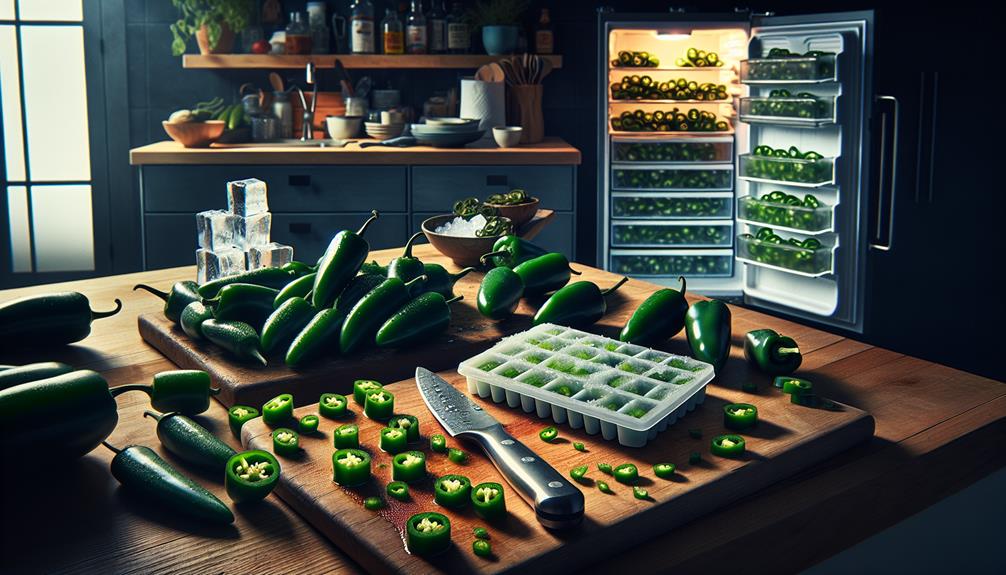Is it true that you can preserve the fiery kick of jalapeños for months by freezing them?
You might've heard that freezing can compromise their texture and flavor, but with the right technique, you can maintain much of their fresh, spicy essence.
To start, you'll need to select firm, vibrant peppers without any blemishes.
Proper preparation involves cleaning them thoroughly, and you might wonder whether to slice, chop, or freeze them whole.
Some argue that blanching jalapeños before freezing helps retain their color and flavor, yet others skip this step for the sake of simplicity.
As you consider the best way to package your peppers for the icy confines of your freezer, remember that the method you choose could make a significant difference in how well your jalapeños withstand the test of time.
Stick around, and you'll uncover the secrets to locking in that spicy goodness for your future culinary adventures.
Key Takeaways
- Choose firm, vibrant peppers without blemishes
- Remove seeds for a milder flavor
- Blanching can help maintain color and slightly soften the peppers
- Use airtight freezer bags or containers to prevent freezer burn
Selecting the Right Jalapeños
Choosing vibrant, firm jalapeños with smooth skins ensures the best results when freezing them for later use. You're looking for peppers that are at their peak of freshness, as these will maintain the best texture and flavor after they've been frozen. Pepper maturity is key; mature jalapeños usually have a bright, consistent color, whether you're picking green or red peppers.
You'll want to consider color choice carefully. Green jalapeños are younger and typically less spicy, with a bit more crispness to them. If you prefer a sweeter and hotter pepper, go for the red ones, which are older and have had more time to develop their heat. Don't be tempted by any jalapeños showing signs of wrinkles or soft spots, as these are indicators that the pepper is past its prime.
Always use your senses to guide you. Fresh jalapeños should feel heavy for their size and have a firm texture that doesn't yield to light pressure. A glossy exterior is also a good sign that you've got a quality pepper in hand.
Prepping Your Peppers
How do you ensure that your carefully selected jalapeños retain their quality when frozen? Let's dive into prepping your peppers for the freezer. The first step is pepper cleaning. Wash your jalapeños thoroughly under cold water to remove any dirt or pesticides. It's crucial to dry them completely; excess moisture can lead to freezer burn, which affects their texture and taste.
Now, let's talk about seed removal. If you prefer a milder flavor, removing the seeds is key, as they contain most of the heat. Slice off the stem end and cut the jalapeño in half lengthwise. Scrape out the seeds and the white membranes with a spoon or a knife, but remember to wear gloves to avoid irritation from the capsaicin.
Here's a quick guide to help you through the process:
| Step | Tool | Tip |
|---|---|---|
| 1. Cleaning | Water | Gently rub under running water, then pat dry. |
| 2. Cutting | Knife | Slice lengthwise for easy seed removal. |
| 3. De-seeding | Spoon/Knife | Wear gloves, scrape gently. |
Once the peppers are clean and de-seeded, you're ready to move on to the next stage: freezing your jalapeños properly to capture their fresh, spicy essence.
Blanching: Optional Steps
Occasionally, you might want to blanch your jalapeños before freezing to preserve their color and flavor. Blanching is a quick dip in boiling water followed by an immediate plunge into ice water. This step isn't strictly necessary for peppers, as they freeze quite well raw, but it does have its benefits.
For one, it can help maintain that vibrant green hue and can slightly soften the peppers, which some people prefer for their cooked dishes.
To blanch your jalapeños, you'll need a pot of boiling water, a bowl of ice water, and a slotted spoon. Wash your peppers, then slice or leave them whole, as you like. Boil them for about two minutes, then swiftly transfer them to the ice bath. This shock halts the cooking process, ensuring your pepper texture remains crisp rather than mushy.
Nutrient retention is another perk of blanching. The quick heat can deactivate enzymes that may cause flavor loss and nutrient degradation over time. Once your jalapeños are thoroughly cooled, drain them and pat dry. They're now ready for freezing, and you can rest assured they'll emerge from the cold as tasty and nutritious as the day you bought them.
Packaging for Freezing
Once your jalapeños are blanched and dried, it's important to package them properly for freezing to ensure they maintain their quality. Here's a straightforward approach to packaging your peppers:
- Choose the Right Container: Use airtight freezer bags or containers to prevent freezer burn. If you've got a vacuum sealer, vacuum sealing your jalapeños will provide the best protection against air and moisture, which are enemies of flavor and texture.
- Prevent Clumping: If you want to use individual jalapeño slices later, lay them out on a baking sheet so they aren't touching and freeze them for an hour before transferring them to your chosen container. This pre-freezing step stops them from sticking together.
- Leave Some Space: When using freezer bags, leave a little space at the top. This allows for expansion as the jalapeños freeze, preventing the bag from splitting or the seal from breaking.
- Label Your Packages: Labeling tips include writing the date of freezing on the container along with the type of cut (sliced, diced, whole). It's a simple step that helps you keep track of your frozen goods and use them within their best quality period.
Thawing and Using Frozen Jalapeños
Thawing your frozen jalapeños properly will ensure they retain their texture and flavor for your culinary uses.
To begin, you don't always need to thaw them. For cooked dishes like soups or stews, toss them directly into the pot. The heat will do the work, and you'll preserve the spice retention that's key to that zesty kick.
If a recipe requires thawed peppers, like for fresh salsas or toppings, place the desired amount of frozen jalapeños in the refrigerator overnight. This slow process helps maintain their structural integrity. For a quicker method, you can use a microwave with a defrost setting, but watch closely to prevent them from getting mushy.
Once thawed, remember that freezing can alter the pepper's texture, making them softer than fresh ones. They're ideal for cooked recipes rather than raw applications where crispness is crucial. Also, consider recipe adjustments; frozen jalapeños might release extra water after thawing, so you might need to tweak the quantities of other ingredients, especially in delicate dishes.
Incorporate your thawed jalapeños as you'd fresh ones, mindful of the potential changes in texture and moisture. This way, you'll add that perfect hint of heat to your meals without compromising on taste or quality.

